
- Index
- Certification
- Composition
- .999 Silver (10)
- .9999 Silver (28)
- 99.99% Pure Silver (29)
- Aluminum (18)
- Bi-metallic (6)
- Billon (10)
- Bronze (54)
- Copper (12)
- Gold (37)
- Gold And Silver (9)
- Gold, Silver (8)
- Nickel (9)
- Pure Silver (14)
- Silver (3440)
- Silver .999 (5)
- Silver 925 / 1000 (13)
- Silver 999 / 1000 (8)
- Silver Certificate (7)
- Silver With Opal (5)
- Varies (6)
- ... (2014)
- Denomination
- Fineness
- Grade
- Year
Antique Japanese Silver Last of the SAMURAI Ryo Pendant 24 18KGF Filled Chain
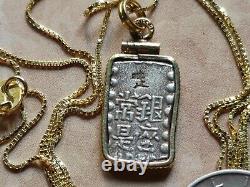
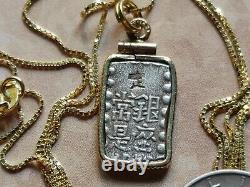
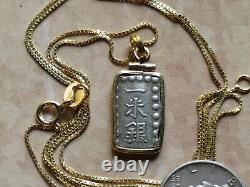
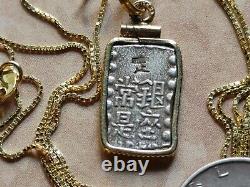
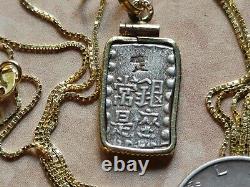
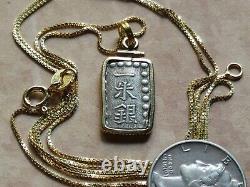
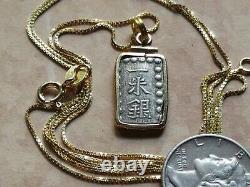
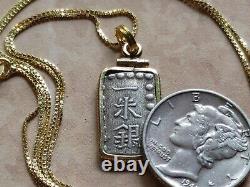


The Last of the Samurai The silver Ryo Shu. 16mm x19mm outside diameter struck in silver. Secured in a gold filled over sterling silver bezel pendant. 80mm Gold Filled Snake Chain.
You have a choice of either a good quality gold filled 3mm wide Figaro Link chain up to 24 inches or a very round gold filled 1.2mm wide snake chain up to 24. Let us know at checkout or by message if you would prefer a figaro link chain or the snake chain type chain shown if no chain is selected we will send the round. The Ryo Shu coin pendant that is being offered is shown with a type of gold filled sterling serpentine style snake chain and has a 1mm width.
Japan didn't have domestic or international conflict. These peaceful times in Tokugawa society enabled bushido to be refined from a focus on valor in battle to more moral integrity. In addition to the "house codes" issued in the context of the fiefdoms (han) and texts that described the right behavior of a warrior (such as the Hagakure), the first Buke shohatto Laws for the Military Houses, ?????Was issued by the government in 1615, which prescribed to the lords of the fiefdoms (daimyo) and the samurai warrior aristocracy responsibilities and activities, the rules of conduct, simple and decent clothing, the correct supply in case of official visits, etc. The edicts were reissued in 1629, and in 1635, by the third shogun Tokugawa Iemitsu.
The new edicts made clear the shogunate's authority and its desire to assert control. The swordsmanship skills of the samurai developed into character-building martial arts. During this period, the samurai class played a central role in the policing and administration of the country. The bushido literature of this time contains much thought relevant to a warrior class seeking more general application of martial principles and experience in peacetime, as well as reflection on the land's long history of war.
[citation needed] The literature of this time includes: Shoke no Hyojo by Ogasawara Sakuun (1621) Budo Shoshinshu????? A Book of Five Rings by Miyamoto Musashi The first mention of the term bushido is in the scriptures Koyo Gunkan???? It consists of 20 scrolls that mention bushido over 30 times.
It contains the history of the Takeda family and their military tactics. [68] The Koyo Gunkan describes valor and exploits in battle. For example it is a waste of talent when a bushido practitioner takes on administrative roles in government or financial affairs e. The scrolls were widely disseminated as a martial arts instruction manual by the samurai class and helped to popularize the term In Koyo Gunkan (1616), bushido is a survival technique for individual fighters, and it aims to make the development of the self and the clan troupe advantageous by raising the samurai name. As symbolized by Asakura Norikage, it is essential to win the battle even with the slander of cowardice. The feature is that it also contains the cold-hearted philosophy. These are mainly related to the way of life as a samurai, and they are the teachings of each family, and they are also equivalent to the treatment of vassals. Hiroko Willcock (senior lecturer at Griffith University, Australia) explained Koyo Gunkan is the earliest comprehensive extant work that provides a notion of bushido as a samurai ethos and the value system of the samurai tradition. However, it does not have a set of principles regarded as "true" or "false", but rather varying perceptions widely regarded as formidable throughout different centuries. As the embodiment of Samurai culture, bushido is correspondingly diverse, drawing selectively on elements of all these traditions to articulate the ethos and discipline of the warrior. For the first time, Confucian ethics (such as Honor and Humanity", "filial piety) became the norm required by samurai. [70] Yamaga Soko was widely viewed as the "Sage of Bushido" in early twentieth-century Japan. Martial arts scholar Ogasawara Sakuun compiled 20 scrolls called Shoke no Hyojo about the military arts in 1621. Therein bushido is described as iji (willpower). The scrolls describe the essence of bushido as the strength to not yield to rewards or power, but adhere to personal convictions that dominate one's inner principles. "Amusing Notes" was written by samurai Saito Chikamori???? Chikamori's pen name was Nyoraishi???The kashoki are 5 scrolls with wide-ranging content, including samurai knowledge with moral precepts, the knowledge of ordinary people, the teachings of Confucian Buddhism, and narrative ones. It has moral precepts which explain theoretical aspects of bushido.
The 5th scroll has an important definition that was made by a samurai: Thus the first known description of morality in bushido and the bushido spirit was the Kashoki. The essence of Bushido is: do not lie, do not be insincere, do not be obsequious, do not be superficial, do not be greedy, do not be rude, do not be boastful, do not be arrogant, do not slander, do not be unfaithful, be on good terms with comrades, do not be overly concerned with events, show concern for one another, be compassionate, with a strong sense of duty.
Being a good samurai takes more than merely a willingness to lay down one's life. 5th scroll of the Kashoki by Saito Chikamori (1642) The kashoki was important with promulgating the bushido spirit among the common population. Thus it was written for commoners, not warriors. Its accessibility made it very popular, because it was written in kana (hiragana and katakana) rather than kanji which can be read by people with elementary school reading skills.There were many editions which had major influence on the behavior of commoners such as adults, adolescents, women and generations. Master swordsman Miyamoto Musashi's life exemplifies bushido. It consists of five volumes (Earth, Water, Fire, Wind and Void). The Book of Earth describes the general framework of bushido.
For example: apply skills in any situation, always carry two swords, learn how to effectively use the lance, naginata, bow and arrow, and guns. A daimyo should know the strength of his troops and how to properly deploy them. Devote yourself to training to master a way, avoid evil acts and thoughts, broaden perspectives with arts and knowledge about different professions, make objective judgments etc. In 1685, the ukiyo-e book Kokon Bushido ezukushi????????? It features heroic popular tales of samurai warriors with simple descriptions per artwork. The title includes the word bushido and it was meant for children which shows that it had spread among the general population.He was fluent in Japanese and learned about bushido. Dai criticized the supposedly violent nature of the traditional Japanese feudal class structure before the Meiji period. Dai said the samurai brutally exploited the class structure to abuse and kill people below them in the social order (and biasedly claimed the opposite for Chinese society as peace-loving). According to Dai, after Confucianism became influential in the 17th century, it brought ideas of benevolence and humanity that pacified the cruel samurai and set Japan upon the course to become a modern and civilized society.
Dai also appreciated aspects of the samurai. For example Dai said: Japan continued to benefit from their spirit of self-sacrifice, selfless loyalty, and-after Confucianism was introduced-compassion. Dai blamed the problems of modern Japan (post-Meiji restoration) due to the loss of samurai virtues when the former merchant class gained power and large corporations started to steer government policy.
Dai said after the samurai class was heavily influenced by Confucian ideals of compassion, their bushido became essentially a "life of blood and tears", because they selflessly shed blood for their lords and cried tears of compassion for farmers and other lower class people. The Hagakure was compiled in the early 18th century, but was kept as a kind of "secret teaching" of the Nabeshima clan until the end of the Tokugawa bakufu (1867). His saying, "I have found the way of the warrior is death", was a summation of the focus on honour and reputation over all else that bushido codified. This is occasionally misinterpreted that bushido is a code of death. The true meaning is by having a constant consciousness of death, people can achieve a state of freedom that transcends life and death, whereby it is possible to perfectly fulfill one's calling as a warrior. Soko attempts to codify a kind of "universal bushido" with a special emphasis on "pure" Confucian values, (rejecting the mystical influences of Tao and Buddhism in Neo-Confucian orthodoxy), while at the same time calling for recognition of the singular and divine nature of Japan and Japanese culture.These radical concepts-including ultimate devotion to the Emperor, regardless of rank or clan-put him at odds with the reigning shogunate. He was exiled to the Ako domain, (the future setting of the 47 Ronin incident), and his works were not widely read until the rise of nationalism in the early 20th century.
[citation needed] Painting of Oishi Yoshio committing seppuku, 1703 The aging Yamamoto Tsunetomo's interpretation of bushido is perhaps more illustrative of the philosophy refined by his unique station and experience, at once dutiful and defiant, ultimately incompatible with the laws of an emerging civil society. Of the 47 ronin-to this day, generally regarded as exemplars of bushido-Tsunetomo felt they were remiss in hatching such a wily, delayed plot for revenge, and had been over-concerned with the success of their undertaking. [citation needed] This romantic sentiment is of course expressed by warriors throughout history, though it may run counter to the art of war itself.
This ambivalence is found in the heart of bushido, and perhaps all such "warrior codes". Some combination of traditional bushido's organic contradictions and more "universal" or "progressive" formulations (like those of Yamaga Soko) would inform Japan's disastrous military ambitions in the 20th century. According to the social psychologist Toshio Yamagishi ja:???? It was the perfect person that fitted the ideal control of the samurai administration in the Edo period.
17mm x19mm tall small diameter antique Japanese authentic coin as shown when compared to an American penny coin. Authentic original Silver Shu square coin the equivalent of 1/16 of a RYO struck Under Emperor Komeii by the. This item is in the category "Coins & Paper Money\Coins: World\Asia\Japan". The seller is "honoredallies" and is located in this country: US. This item can be shipped worldwide.- Denomination: sho
- Composition: Silver
- Year: 1860s
- Country/Region of Manufacture: Japan
- Certification: Uncertified

